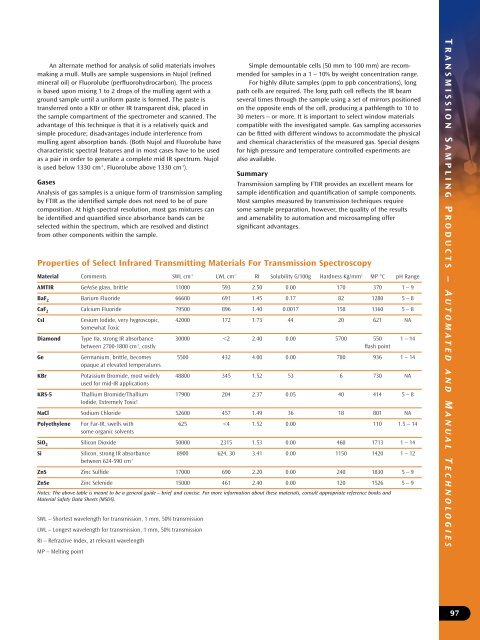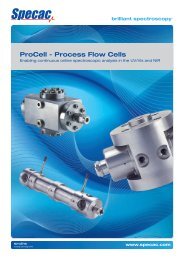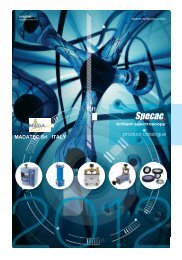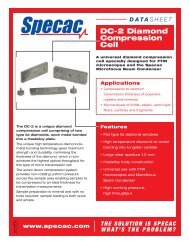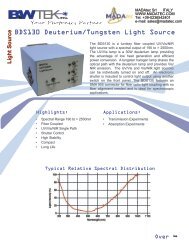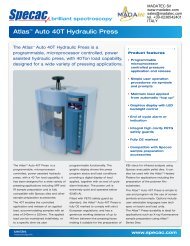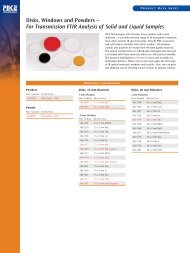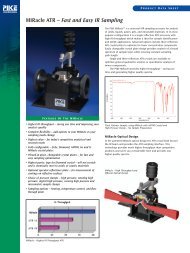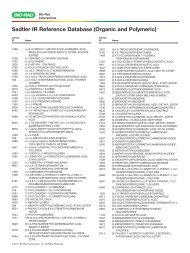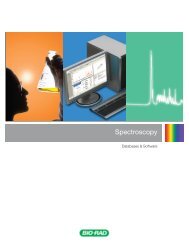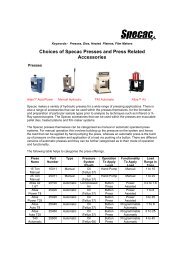Pike Technologies Comprehensive Catalog of FTIR ... - Madatec
Pike Technologies Comprehensive Catalog of FTIR ... - Madatec
Pike Technologies Comprehensive Catalog of FTIR ... - Madatec
You also want an ePaper? Increase the reach of your titles
YUMPU automatically turns print PDFs into web optimized ePapers that Google loves.
An alternate method for analysis <strong>of</strong> solid materials involves<br />
making a mull. Mulls are sample suspensions in Nujol (refined<br />
mineral oil) or Fluorolube (perfluorohydrocarbon). The process<br />
is based upon mixing 1 to 2 drops <strong>of</strong> the mulling agent with a<br />
ground sample until a uniform paste is formed. The paste is<br />
transferred onto a KBr or other IR transparent disk, placed in<br />
the sample compartment <strong>of</strong> the spectrometer and scanned. The<br />
advantage <strong>of</strong> this technique is that it is a relatively quick and<br />
simple procedure; disadvantages include interference from<br />
mulling agent absorption bands. (Both Nujol and Fluorolube have<br />
characteristic spectral features and in most cases have to be used<br />
as a pair in order to generate a complete mid IR spectrum. Nujol<br />
is used below 1330 cm -1 , Fluorolube above 1330 cm -1 ).<br />
Gases<br />
Analysis <strong>of</strong> gas samples is a unique form <strong>of</strong> transmission sampling<br />
by <strong>FTIR</strong> as the identified sample does not need to be <strong>of</strong> pure<br />
composition. At high spectral resolution, most gas mixtures can<br />
be identified and quantified since absorbance bands can be<br />
selected within the spectrum, which are resolved and distinct<br />
from other components within the sample.<br />
Simple demountable cells (50 mm to 100 mm) are recommended<br />
for samples in a 1 – 10% by weight concentration range.<br />
For highly dilute samples (ppm to ppb concentrations), long<br />
path cells are required. The long path cell reflects the IR beam<br />
several times through the sample using a set <strong>of</strong> mirrors positioned<br />
on the opposite ends <strong>of</strong> the cell, producing a pathlength to 10 to<br />
30 meters – or more. It is important to select window materials<br />
compatible with the investigated sample. Gas sampling accessories<br />
can be fitted with different windows to accommodate the physical<br />
and chemical characteristics <strong>of</strong> the measured gas. Special designs<br />
for high pressure and temperature controlled experiments are<br />
also available.<br />
Summary<br />
Transmission sampling by <strong>FTIR</strong> provides an excellent means for<br />
sample identification and quantification <strong>of</strong> sample components.<br />
Most samples measured by transmission techniques require<br />
some sample preparation, however, the quality <strong>of</strong> the results<br />
and amenability to automation and microsampling <strong>of</strong>fer<br />
significant advantages.<br />
Properties <strong>of</strong> Select Infrared Transmitting Materials For Transmission Spectroscopy<br />
Material Comments SWL cm -1 LWL cm -1 RI Solubility G/100g Hardness Kg/mm 2 MP °C pH Range<br />
AMTIR GeAsSe glass, brittle 11000 593 2.50 0.00 170 370 1 – 9<br />
BaF 2 Barium Fluoride 66600 691 1.45 0.17 82 1280 5 – 8<br />
CaF 2 Calcium Fluoride 79500 896 1.40 0.0017 158 1360 5 – 8<br />
CsI Cesium Iodide, very hygroscopic, 42000 172 1.73 44 20 621 NA<br />
Somewhat Toxic<br />
Diamond Type IIa, strong IR absorbance 30000


